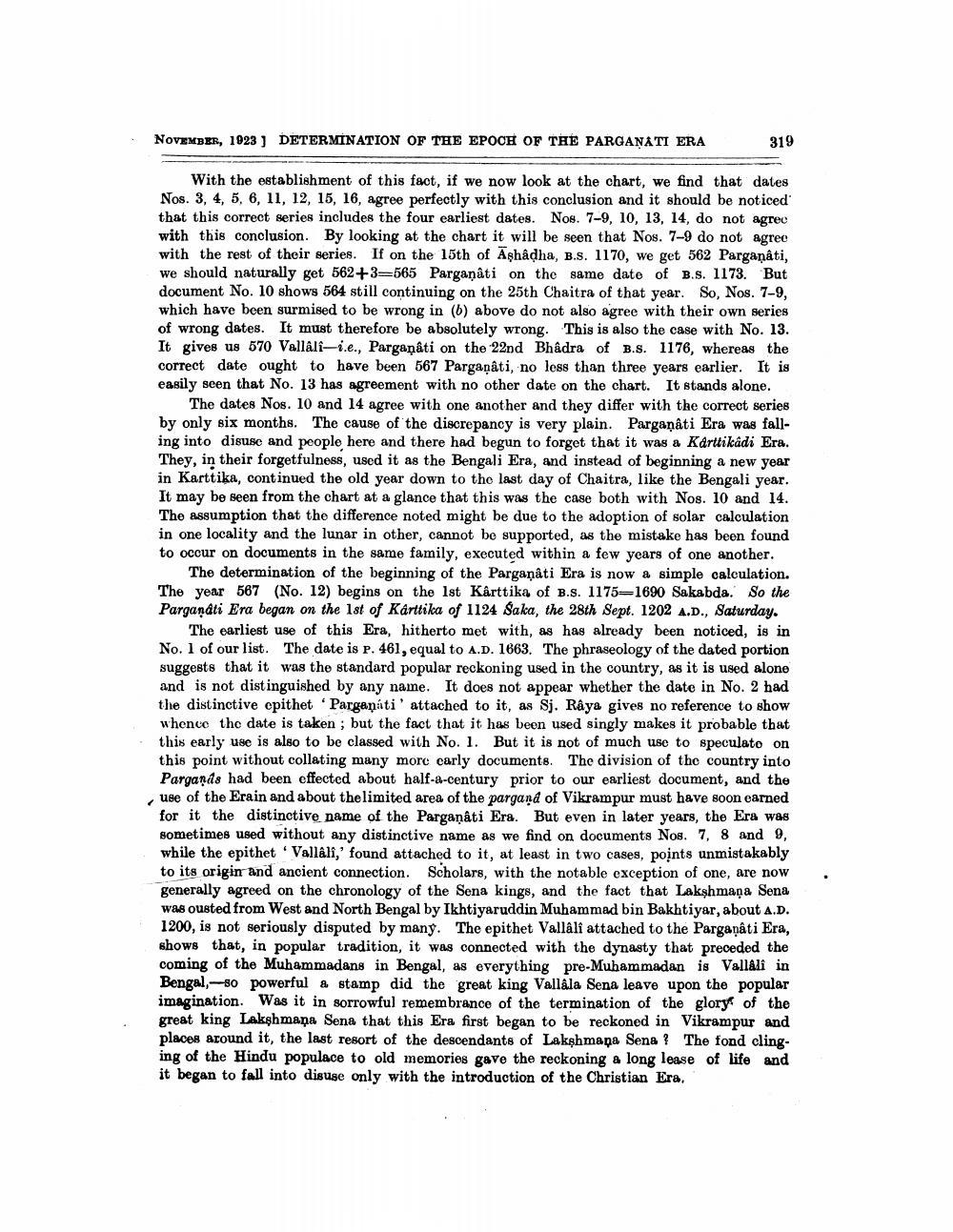________________
NOVEMBER, 1923] DETERMINATION OF THE EPOCH OF THE PARGANATI ERA
With the establishment of this fact, if we now look at the chart, we find that dates Nos. 3, 4, 5, 6, 11, 12, 15, 16, agree perfectly with this conclusion and it should be noticed that this correct series includes the four earliest dates. Nos. 7-9, 10, 13, 14, do not agree with this conclusion. By looking at the chart it will be seen that Nos. 7-9 do not agree with the rest of their series. If on the 15th of Ashâdha, B.S. 1170, we get 562 Parganâti, we should naturally get 562+3=565 Parganâti on the same date of B.S. 1173. But document No. 10 shows 564 still continuing on the 25th Chaitra of that year. So, Nos. 7-9, which have been surmised to be wrong in (b) above do not also agree with their own series of wrong dates. It must therefore be absolutely wrong. This is also the case with No. 13. It gives us 570 Vallâlî-i.e., Parganâti on the 22nd Bhâdra of B.S. 1176, whereas the correct date ought to have been 567 Parganâti, no less than three years earlier. It is easily seen that No. 13 has agreement with no other date on the chart. It stands alone.
319
The dates Nos. 10 and 14 agree with one another and they differ with the correct series by only six months. The cause of the discrepancy is very plain. Parganâti Era was falling into disuse and people here and there had begun to forget that it was a Karttikâdi Era. They, in their forgetfulness, used it as the Bengali Era, and instead of beginning a new year in Karttika, continued the old year down to the last day of Chaitra, like the Bengali year. It may be seen from the chart at a glance that this was the case both with Nos. 10 and 14. The assumption that the difference noted might be due to the adoption of solar calculation in one locality and the lunar in other, cannot be supported, as the mistake has been found to occur on documents in the same family, executed within a few years of one another.
The determination of the beginning of the Parganâti Era is now a simple calculation. The year 567 (No. 12) begins on the 1st Kârttika of B.S. 1175-1690 Sakabda. So the Parganati Era began on the 1st of Kárttika of 1124 Saka, the 28th Sept. 1202 A.D., Saturday.
The earliest use of this Era, hitherto met with, as has already been noticed, is in No. 1 of our list. The date is P. 461, equal to A.D. 1663. The phraseology of the dated portion suggests that it was the standard popular reckoning used in the country, as it is used alone and is not distinguished by any name. It does not appear whether the date in No. 2 had the distinctive epithet Parganati' attached to it, as Sj. Râya gives no reference to show whence the date is taken; but the fact that it has been used singly makes it probable that this early use is also to be classed with No. 1. But it is not of much use to speculate on this point without collating many more early documents. The division of the country into Parganas had been effected about half-a-century prior to our earliest document, and the use of the Erain and about the limited area of the pargand of Vikrampur must have soon earned for it the distinctive name of the Parganâti Era. But even in later years, the Era was sometimes used without any distinctive name as we find on documents Nos. 7, 8 and 9, while the epithet 'Vallâlî,' found attached to it, at least in two cases, points unmistakably to its origin and ancient connection. Scholars, with the notable exception of one, are now generally agreed on the chronology of the Sena kings, and the fact that Lakshmana Sena was ousted from West and North Bengal by Ikhtiyaruddin Muhammad bin Bakhtiyar, about A.D. 1200, is not seriously disputed by many. The epithet Vallâlî attached to the Parganâti Era, shows that, in popular tradition, it was connected with the dynasty that preceded the coming of the Muhammadans in Bengal, as everything pre-Muhammadan is Vallâlî in Bengal, so powerful a stamp did the great king Vallâla Sena leave upon the popular imagination. Was it in sorrowful remembrance of the termination of the glory of the great king Lakshmana Sena that this Era first began to be reckoned in Vikrampur and places around it, the last resort of the descendants of Lakshmana Sena? The fond clinging of the Hindu populace to old memories gave the reckoning a long lease of life and it began to fall into disuse only with the introduction of the Christian Era.




